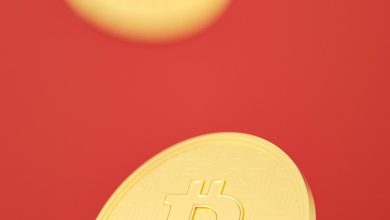DeFi Market Insights: Growth, Challenges, and Opportunities

- Understanding the DeFi Market Landscape
- Exploring the Factors Driving the Growth of DeFi
- Challenges Faced by the DeFi Market and How to Overcome Them
- Opportunities for Innovation and Expansion in DeFi
- Regulatory Environment and Its Impact on the DeFi Market
- Investment Strategies for Navigating the Volatility of DeFi
Understanding the DeFi Market Landscape
The DeFi market landscape is a dynamic and rapidly evolving space that offers a wide range of opportunities for investors, developers, and users alike. Understanding the different aspects of the DeFi market can help stakeholders navigate the challenges and capitalize on the growth potential of this emerging sector.
One key aspect of the DeFi market landscape is the variety of decentralized financial products and services available to users. These can include decentralized exchanges, lending platforms, asset management protocols, and more. Each of these services operates on blockchain technology, enabling peer-to-peer transactions without the need for traditional financial intermediaries.
Another important feature of the DeFi market is the emphasis on transparency and security. Smart contracts, which are self-executing contracts with the terms of the agreement directly written into code, are a key component of many DeFi protocols. These contracts help ensure that transactions are executed as intended and that the funds are secure from hacking or fraud.
Despite the growth and potential of the DeFi market, there are also challenges to be aware of. These can include regulatory uncertainty, scalability issues, and the risk of smart contract bugs or vulnerabilities. It is essential for stakeholders to stay informed about these challenges and work towards solutions that promote the long-term sustainability of the DeFi ecosystem.
Overall, the DeFi market landscape is a vibrant and innovative sector that is reshaping the future of finance. By understanding the opportunities and challenges of this space, stakeholders can position themselves to take advantage of the growth potential and contribute to the ongoing evolution of decentralized finance.
Exploring the Factors Driving the Growth of DeFi
The growth of the DeFi market can be attributed to several key factors that are driving its expansion. One of the main drivers is the increasing demand for decentralized financial services, which offer users greater control over their assets without the need for intermediaries. This shift towards decentralized finance is fueled by the desire for greater financial inclusion and accessibility, especially in regions where traditional banking services are limited. Additionally, the rise of blockchain technology has enabled the development of sophisticated DeFi platforms that provide users with innovative solutions for lending, borrowing, and trading digital assets. These platforms leverage smart contracts to automate processes and eliminate the need for manual intervention, making them more efficient and cost-effective. As a result, more investors and users are turning to DeFi for its potential to generate higher returns and diversify their portfolios in a rapidly evolving market.
Challenges Faced by the DeFi Market and How to Overcome Them
One of the major challenges faced by the DeFi market is the issue of security. With the increasing popularity of decentralized finance, hackers are constantly looking for vulnerabilities to exploit. This poses a significant threat to users’ funds and the overall credibility of the DeFi ecosystem. To overcome this challenge, developers and stakeholders must prioritize security measures such as code audits, bug bounties, and robust encryption protocols.
Another obstacle in the DeFi market is the lack of regulation. While decentralization is a key feature of DeFi, the absence of clear regulatory guidelines leaves room for uncertainty and potential risks for investors. To address this challenge, industry stakeholders need to work closely with regulators to establish a framework that ensures investor protection without stifling innovation in the DeFi space.
Scalability is also a pressing issue for the DeFi market. As the number of users and transactions continues to grow, existing blockchain networks may struggle to keep up with the demand, leading to network congestion and high transaction fees. To tackle this challenge, developers are exploring solutions such as layer 2 scaling solutions, interoperability protocols, and sharding to improve the scalability of DeFi platforms.
Moreover, the user experience in DeFi applications can be complex and daunting for newcomers. The technical jargon, complex interfaces, and steep learning curve can deter potential users from participating in the DeFi ecosystem. To make DeFi more accessible and user-friendly, developers should focus on improving the onboarding process, providing better education resources, and designing intuitive interfaces that simplify the user experience.
In conclusion, while the DeFi market presents significant growth opportunities, it also faces several challenges that need to be addressed to ensure its long-term success. By prioritizing security, working with regulators, improving scalability, and enhancing the user experience, the DeFi ecosystem can overcome these obstacles and realize its full potential as a transformative force in the world of finance.
Opportunities for Innovation and Expansion in DeFi
DeFi presents numerous opportunities for innovation and expansion in the market. As the industry continues to grow rapidly, there are several areas where new developments can drive further progress and adoption.
- Interoperability: Enhancing interoperability between different DeFi platforms can create a more seamless experience for users and increase overall efficiency in the ecosystem.
- Scalability: Improving scalability will be crucial for DeFi to handle larger transaction volumes and accommodate a growing user base.
- Security: Strengthening security measures is essential to build trust among users and protect their assets from potential threats.
- Regulatory Compliance: Addressing regulatory concerns and ensuring compliance with relevant laws will be key to sustaining long-term growth and legitimacy in the DeFi space.
- User Experience: Enhancing the user experience through intuitive interfaces and streamlined processes can attract more mainstream users to DeFi applications.
By focusing on these areas of innovation and expansion, the DeFi market can overcome current challenges and continue to thrive in the evolving landscape of decentralized finance.
Regulatory Environment and Its Impact on the DeFi Market
The regulatory environment has a significant impact on the decentralized finance (DeFi) market. As governments and regulatory bodies around the world continue to grapple with how to classify and oversee DeFi platforms, uncertainty prevails in the industry. The lack of clear regulatory guidelines can create challenges for DeFi projects looking to operate within the bounds of the law while also innovating in this rapidly evolving space.
Regulatory scrutiny has the potential to stifle innovation in the DeFi market, as projects may be hesitant to launch new products or services for fear of running afoul of regulations. Additionally, regulatory actions can lead to increased compliance costs, which may be passed on to users in the form of higher fees or restricted access to certain services.
On the other hand, some level of regulation may be necessary to protect investors and ensure the stability of the financial system. By establishing clear guidelines for DeFi projects to follow, regulators can help build trust and credibility in the industry, ultimately attracting more users and investment.
Overall, finding the right balance between innovation and regulation will be crucial for the long-term growth and sustainability of the DeFi market. As the regulatory environment continues to evolve, DeFi projects will need to stay informed and adaptable to navigate the changing landscape successfully.
Investment Strategies for Navigating the Volatility of DeFi
Investors looking to navigate the volatility of the DeFi market can employ various investment strategies to mitigate risks and capitalize on opportunities. One approach is to diversify their portfolio across different DeFi projects to spread out risk exposure. By spreading investments across multiple projects, investors can reduce the impact of any single project’s failure on their overall portfolio.
Another strategy is to stay informed about the latest trends and developments in the DeFi space. By staying up-to-date with market news and project updates, investors can make more informed decisions about when to buy, sell, or hold their DeFi assets. Additionally, monitoring the performance of different projects and analyzing their fundamentals can help investors identify strong projects with long-term potential.
Furthermore, investors can consider using risk management tools such as stop-loss orders and hedging strategies to protect their investments from significant losses during periods of high volatility. Stop-loss orders automatically sell assets when their prices reach a certain threshold, helping investors limit their losses. Hedging strategies, such as options trading or futures contracts, can also provide protection against adverse price movements in the market.
Moreover, investors should pay attention to the overall market sentiment and be prepared to act quickly in response to market developments. By closely monitoring market sentiment indicators and staying flexible in their investment approach, investors can adapt to changing market conditions and capitalize on opportunities as they arise.
In conclusion, navigating the volatility of the DeFi market requires a combination of diversification, information, risk management, and market awareness. By employing these investment strategies, investors can better position themselves to succeed in the dynamic and rapidly evolving world of decentralized finance.



